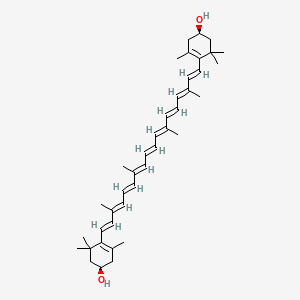| MeSH term | MeSH ID | Detail |
|---|---|---|
| Inflammation | D007249 | 119 associated lipids |
Zeaxanthin
Zeaxanthin is a lipid of Prenol Lipids (PR) class. Zeaxanthin is associated with abnormalities such as Disintegration (morphologic abnormality), Alkalemia, Age related macular degeneration, Visual impairment and Consumption-archaic term for TB. The involved functions are known as Signal, Regulation, Energy Transfer, Process and Pigment. Zeaxanthin often locates in Chloroplast thylakoids, reaction center, Tissue membrane, PSII associated light-harvesting complex II and Thylakoid Membrane. The associated genes with Zeaxanthin are PRB2 gene, Structural gene, Polypeptides, Genes, Bacterial and Genes, rRNA. The related lipids are Membrane Lipids, Micelles, Fatty Acids, Lipid Peroxides and monogalactosyldiacylglycerol. The related experimental models are Knock-out.
Cross Reference
Introduction
To understand associated biological information of Zeaxanthin, we collected biological information of abnormalities, associated pathways, cellular/molecular locations, biological functions, related genes/proteins, lipids and common seen animal/experimental models with organized paragraphs from literatures.
What diseases are associated with Zeaxanthin?
Zeaxanthin is suspected in Dermatitis, Phototoxic, Age related macular degeneration, Cataract, Disintegration, Reflex Epilepsy, Photosensitive, Dehydration and other diseases in descending order of the highest number of associated sentences.
Related references are mostly published in these journals:
| Disease | Cross reference | Weighted score | Related literature |
|---|
Possible diseases from mapped MeSH terms on references
We collected disease MeSH terms mapped to the references associated with Zeaxanthin
PubChem Associated disorders and diseases
What pathways are associated with Zeaxanthin
There are no associated biomedical information in the current reference collection.
PubChem Biomolecular Interactions and Pathways
Link to PubChem Biomolecular Interactions and PathwaysWhat cellular locations are associated with Zeaxanthin?
Visualization in cellular structure
Associated locations are in red color. Not associated locations are in black.
Related references are published most in these journals:
| Location | Cross reference | Weighted score | Related literatures |
|---|
What functions are associated with Zeaxanthin?
Related references are published most in these journals:
| Function | Cross reference | Weighted score | Related literatures |
|---|
What lipids are associated with Zeaxanthin?
Related references are published most in these journals:
| Lipid concept | Cross reference | Weighted score | Related literatures |
|---|
What genes are associated with Zeaxanthin?
Related references are published most in these journals:
| Gene | Cross reference | Weighted score | Related literatures |
|---|
What common seen animal models are associated with Zeaxanthin?
Knock-out
Knock-out are used in the study 'Zeaxanthin binds to light-harvesting complex stress-related protein to enhance nonphotochemical quenching in Physcomitrella patens.' (Pinnola A et al., 2013).
Related references are published most in these journals:
| Model | Cross reference | Weighted score | Related literatures |
|---|
NCBI Entrez Crosslinks
All references with Zeaxanthin
Download all related citations| Authors | Title | Published | Journal | PubMed Link |
|---|---|---|---|---|
| Forman MR et al. | Effect of menstrual cycle phase on the concentration of individual carotenoids in lipoproteins of premenopausal women: a controlled dietary study. | 1998 | Am. J. Clin. Nutr. | pmid:9440379 |
| Grolier P et al. | In vitro and in vivo inhibition of beta-carotene dioxygenase activity by canthaxanthin in rat intestine. | 1997 | Arch. Biochem. Biophys. | pmid:9434733 |
| Mortensen A et al. | Comparative mechanisms and rates of free radical scavenging by carotenoid antioxidants. | 1997 | FEBS Lett. | pmid:9414102 |
| Woodall AA et al. | Carotenoids and protection of phospholipids in solution or in liposomes against oxidation by peroxyl radicals: relationship between carotenoid structure and protective ability. | 1997 | Biochim. Biophys. Acta | pmid:9367186 |
| Zang LY et al. | Absorbance changes of carotenoids in different solvents. | 1997 | Free Radic. Biol. Med. | pmid:9358253 |
| Ruther A et al. | Production of zeaxanthin in Escherichia coli transformed with different carotenogenic plasmids. | 1997 | Appl. Microbiol. Biotechnol. | pmid:9299773 |
| Hammond BR et al. | Density of the human crystalline lens is related to the macular pigment carotenoids, lutein and zeaxanthin. | 1997 | Optom Vis Sci | pmid:9293517 |
| Khachik F et al. | Identification of lutein and zeaxanthin oxidation products in human and monkey retinas. | 1997 | Invest. Ophthalmol. Vis. Sci. | pmid:9286269 |
| Hammond BR et al. | Dietary modification of human macular pigment density. | 1997 | Invest. Ophthalmol. Vis. Sci. | pmid:9286268 |
| Koonsvitsky BP et al. | Olestra affects serum concentrations of alpha-tocopherol and carotenoids but not vitamin D or vitamin K status in free-living subjects. | 1997 | J. Nutr. | pmid:9237960 |
